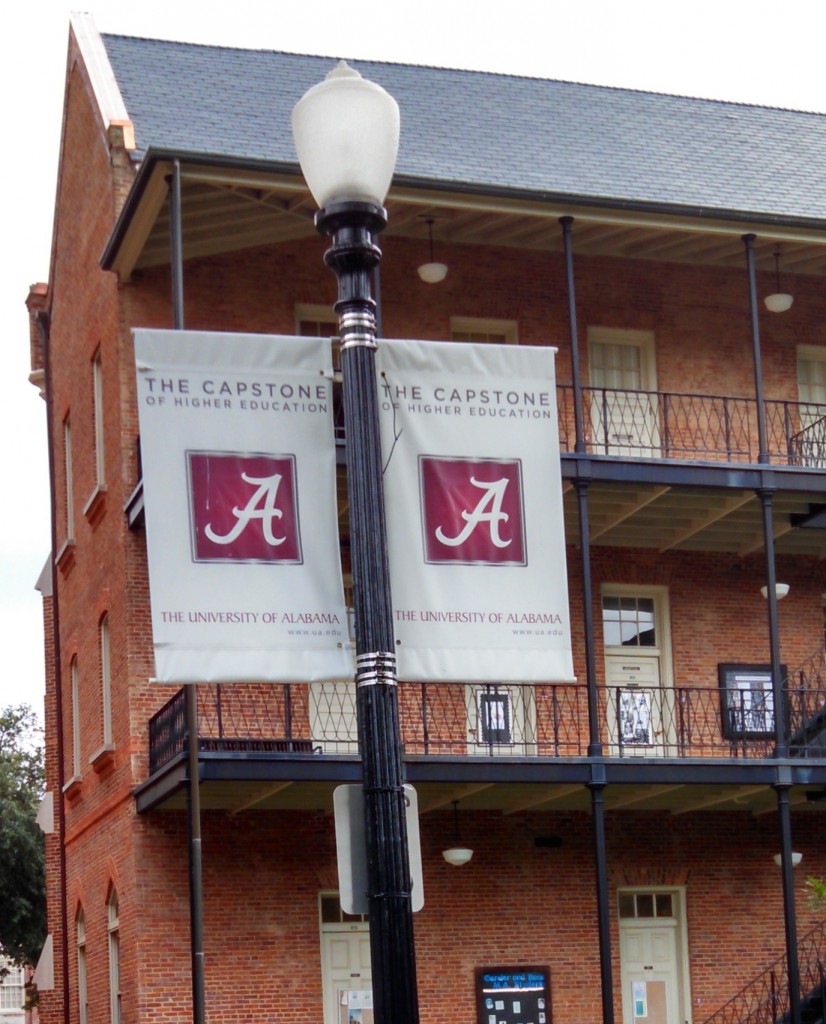 What makes the “Capstone A” (central on the banners outside Manly Hall in my photo above) special? What makes people associate it with the University of Alabama? It is not something inherent in the font or colors that gives it a different significance from any other uppercase A. It has been a long-term, extremely successful effort at branding by the University of Alabama, and especially its athletic programs, that give the symbol a generally positive, sometimes passionate, association with the University. To keep that significance as something set apart, the university restricts the use of this trademarked A. Outside companies, and even departments and organizations on campus, must go through an approval process to put the A (or any university symbol) on a t-shirt or mug, for example. For people outside the university, that process requires buying a license to use it, as the local bakery featured in this recent Marketplace story had to do.
What makes the “Capstone A” (central on the banners outside Manly Hall in my photo above) special? What makes people associate it with the University of Alabama? It is not something inherent in the font or colors that gives it a different significance from any other uppercase A. It has been a long-term, extremely successful effort at branding by the University of Alabama, and especially its athletic programs, that give the symbol a generally positive, sometimes passionate, association with the University. To keep that significance as something set apart, the university restricts the use of this trademarked A. Outside companies, and even departments and organizations on campus, must go through an approval process to put the A (or any university symbol) on a t-shirt or mug, for example. For people outside the university, that process requires buying a license to use it, as the local bakery featured in this recent Marketplace story had to do.
That Marketplace story illustrates clearly the process of creating something that is sacred, something that is set apart from the everyday (using a Durkheimian definition). The rules that limit who uses it and in what circumstances help to generate, over time, its significance, thus making it special and sacred. As these rules are constructed within a society, they illustrate Durkheim’s point that the community constructs the significance given to things, their sacredness. The specialness, therefore, is not inherent in the symbol but is generated through the restrictions and actions of the community that develops it.
That sacredness and the restrictions that inform it serve to maintain particular social relationships. As access is restricted, those with access have a privilege that the restrictions maintain, which can translate into power, money, and prestige. Of course, seldom are the efforts to define significance unanimous. As the Marketplace story points out, the effort to protect the use of this A requires judgments about what counts as a protected A, judgments that generate debate.
Similar debates over what counts as something sacred are evident across the news, from debates about what forms of marriage are sacred restrictions that a person should not violate and what end-of-life practices are sacred for people who identify as Jains and thus should not be prohibited. In this way, Durkheim’s idea about the social construction of the sacred helps to explain both contemporary branding and divisions in religious communities. You do not have to accept or reject the existence of the divine to find Durkheim useful for analyzing the ways communities express and contest what symbols, texts, beliefs and practices have a special status.